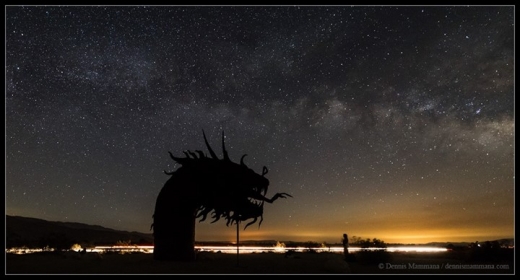
By Mark and Miriam Raftery
Photo, left: Milky Way galazy and dragon sculpture in Anza Borrego Desert; © Dennis Mammana/dennismammana.com
July 4, 2015 (Borrego Springs) – Stargazing guru Dennis Mammana has been photographing the night sky for nearly a half century and leading night sky tours for nearly thirty years. He also teaches workshops that provide in-depth tips on how you can photograph everything from the Milky Way to constellations – and as we discovered last weekend in Borrego, you don’t have to have a backpack full of professional camera gear to come up with some gorgeous images.
Borrego Springs in 2009 became the first designated International Dark Sky Community in California--thanks in part to the efforts of our helpful host, teacher and guide. That means there are no bright lights at night to interview with your night-sky viewing pleasure.
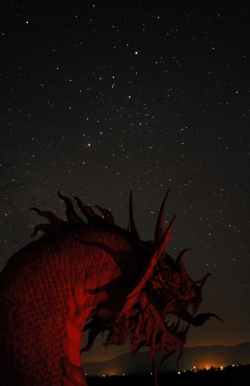 Mark signed up for the two-day workshop and Miriam came along for the night sky tours, though the first night was disrupted by smoke from the Lake Fire in San Bernadino County. Night two was well worth the wait, however!
Mark signed up for the two-day workshop and Miriam came along for the night sky tours, though the first night was disrupted by smoke from the Lake Fire in San Bernadino County. Night two was well worth the wait, however!
As we waiting for twilight to descend over the Anza Borrego Desert, bringing cooling relief from the summer heat, we took photos of fantastic giant sculptures of prehistoric creatures that once roamed this place – along with a whimsical sea serpent sculpture that appears to undulate through the desert floor. (Photo, right, by Mark Raftery.) All of the sculptures were created by artist Ricardo Breceda.
Dennis used a laser pointer shot up into the sky to point out passage of the Hubble Telescope and the International Space Station, as well as another satellite. We watched the moon rise, then set beyond the mountains in the west. (Photo, left, b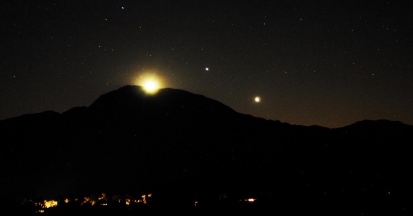 y Mark Raftery with Jupiter and Venus visible to right of moon.)
y Mark Raftery with Jupiter and Venus visible to right of moon.)
Then the main attraction appeared: the magnificent Milky Way galazy, a spangle of countless stars rising across that indigo night sky. Using techniques learned in the workshop, Mark captured both the Milky Way above and the faint glow of lights in distant El Centro on the horizon.
Dennis (photo, left, by Miriam Raftery) pens a syndicated stargazing column and leads celestial viewing treks around the world for events ranging from eclipses to viewing the Aurora Borealis (Northern Lights) when he's not at home in Borrego Springs, where he leads his popular night sky tours and workshops throughout the summer.
Here are a few tips from his recent workshop—though there’s a lot more you can learn if you come in person!
[1] You can get excellent night sky photos with a basic 35 mm digital camera, a wide angle lens, and a sturdy tripod. If you can see it, you can photograph it.
[2] When taking photos of the night sky, turn you camera's auto focus feature off and use manual focus to get the sharpest photos; focus on a star to be sure your photos are sharp.
[3] Always experiment with your photos -- consider your aperture (the size of the opening in your lens), the exposure (how long your lens stays open when you take your picture), and your ISO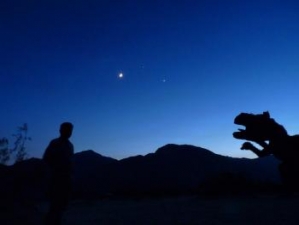 (how sensitive the sensor in your camera is to light).
(how sensitive the sensor in your camera is to light).
[4] Consider including people in your photos to make them more interesting. (photo, right, by Miriam Raftery)
[5] Remember you create photos, you don't just take them.
[6] Consider the 'Rule of Thirds" (divide your photograph into three equally spaced vertical and horizontal lines) and place the most important parts of your photos where the lines intersect.
[7] Practice makes perfect -- compose your photo, check your exposure, take your photo, make adjustments and repeat.
[8] Post production, you can do image processing with Photoshop. Light Room, or a similar program. Your photo is never really finished!
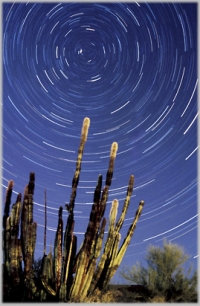
You can also learn more advanced techniques, such as how to create circular "star trails" by attending one of the workshops. (Photo, right, by Dennis Mammana)
Have fun and go with the flow! When smoke from the Lake fire forced cancellation of our first astronomical viewing night, we did get some dazzling, one-of-a-kind sunset shots. (Photo, below left by Miriam Raftery: Sunset through smoke from the Lake Fire, viewed from Borrego Springs.)
To learn more or to sign up for a night sky tour, workshop or photo trip with Dennis Mammana (c), you can visit www.dennismammana.com or follow his Facebook page at http://www.facebook.com/DennisMammana
Photos: Below left, Sunset through smoke from the Lake Fire; photo by Miriam Raftery
Below right, Milky Way with lights of El Centro in background; photo by Mark Raftery
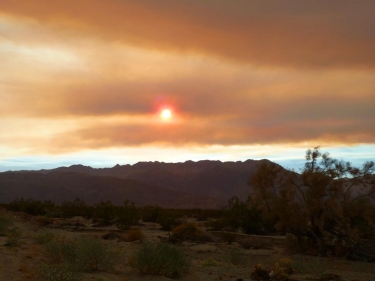
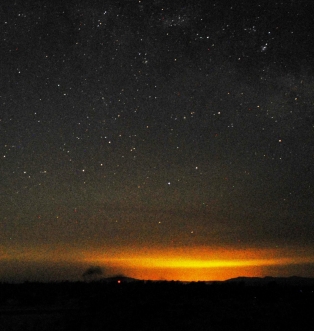







Recent comments